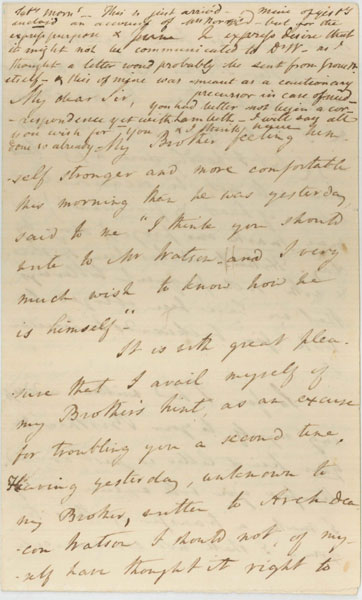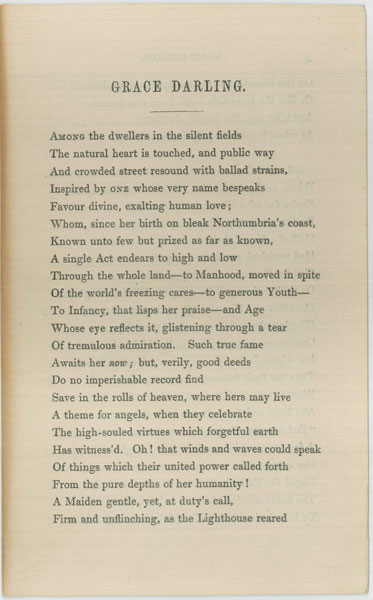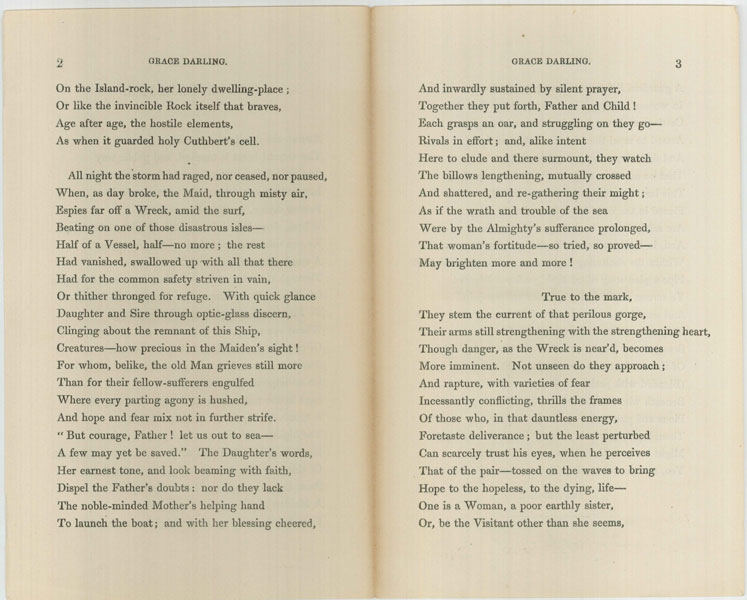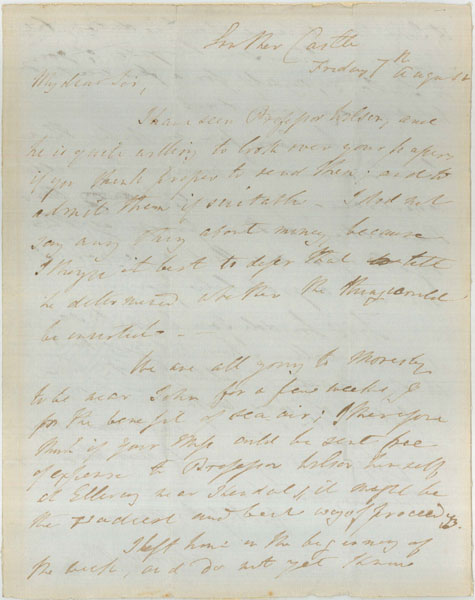Courtesy of the Armstrong Browning Library
By Michael Milburn, Graduate Assistant, Armstrong Browning Library
William Wordsworth was the foremost of the early Romantic poets in England, known on the one hand for his use of familiar imagery and language; on the other, for his complex and contemplative blank verse; and in either case, for his devotion to nature. Notable works include Lyrical Ballads (1798 and 1800) and The Prelude, which was not published until after his death in 1850.
The ABL has several rare editions of Wordsworth’s poetry, including three inscribed copies, in addition to five unpublished or partially published letters.
William Wordsworth. The Poetical Works of William Wordsworth. New ed. London: Longman, Rees, Orme, Brown, Green & Longman, 1832.
The author’s inscription reads as follows: “To Lady Townshend Farquhar / in token of affectionate Regard / from her / Sincere Friend / Wm Wordsworth / Rydal Mount / 14th Novbr 1832.” Lady Maria Frances Geslip (née de Latour) was the widow of Sir Robert Townsend Farquhar, a Member of Parliament.
William Wordsworth. Grace Darling. Carlisle: Printed at the office of Charles Thurnam, 1843.
Privately printed and inscribed by the author.
In his poem, Wordsworth celebrates the heroics of Grace Darling, who became a Victorian icon for her role in rescuing the survivors of the Forfarshire after it was shipwrecked near her father’s lighthouse in 1838. This extremely rare edition once belonged to the American musical theater composer Jerome Kern.
Letter from William Wordsworth to Francis Merewether. 7 August [1829].
Francis Merewether was a High-Church priest and pamphleteer who had asked Wordsworth to speak on his behalf to Professor John Wilson, best known for his contributions to Blackwood’s Edinburgh Magazine under the pseudonym of Christopher North. Wordsworth obliged with this reply, reporting that “Professor Wilson” would be “willing to look over” Merewether’s “papers . . . and to admit them if suitable.”
William Wordsworth. Lyrical Ballads, with a Few Other Poems. London: J. & A. Arch, 1798.
First edition, second issue. Possibly the first printing to be sold instead of privately distributed.
The anonymous publication of the Lyrical Ballads in 1798 was one of the most important events in British literary history. Wordsworth’s collection, with several contributions by Coleridge, ushered in a new era in which imagination and emotion mattered more than formal poetic diction.
Letter from William Wordsworth to Allan Cunningham 8 January 1827.
The “Mr. Kenyon” to whom Wordsworth refers in this letter is probably John Kenyon, fellow poet and friend to Wordsworth and Coleridge, as well as to the Brownings, whom he introduced to each other. Wordsworth wants Cunningham to vote in favor of Kenyon’s acceptance to the Athenaeum club, whose members would eventually include Michael Faraday, Matthew Arnold, and William Makepeace Thackeray.
 Letter from William Wordsworth to John Abraham Heraud. 10 June [1834].
Letter from William Wordsworth to John Abraham Heraud. 10 June [1834].
Wordsworth had recently been instructed to rest his eyes, so he had been unable to read Heraud’s Judgment of the Flood on his own. His excuse for not having the entire work read aloud suggests how he might have hoped his own philosophical poetry would be read, at least when he was not reciting it himself:
You are a thinking writer–& I said “I must not go on with this, till I can have my eyes upon the page” & this I beg you would take as expressing of real admiration.

Letter from Dorothy Wordsworth to Joshua Watson and Archdeacon Watson. [2 June 1820].
Dorothy Wordsworth was William Wordsworth’s sister, close friend, and longtime collaborator. Her journals reveal many details about life in the household she shared with her brother and his family. Here, she comments on the health of her youngest brother, Christopher.
The Armstrong Browning Library owns several other Wordsworth letters:
Letter from William Wordsworth to Unidentified Correspondent. 15 September 1818.
Letter from William Wordsworth the Unidentified Correspondent. 27 November 1835.
Letter from Christopher Wordsworth to Mr. Smith. 1 October 1844.








